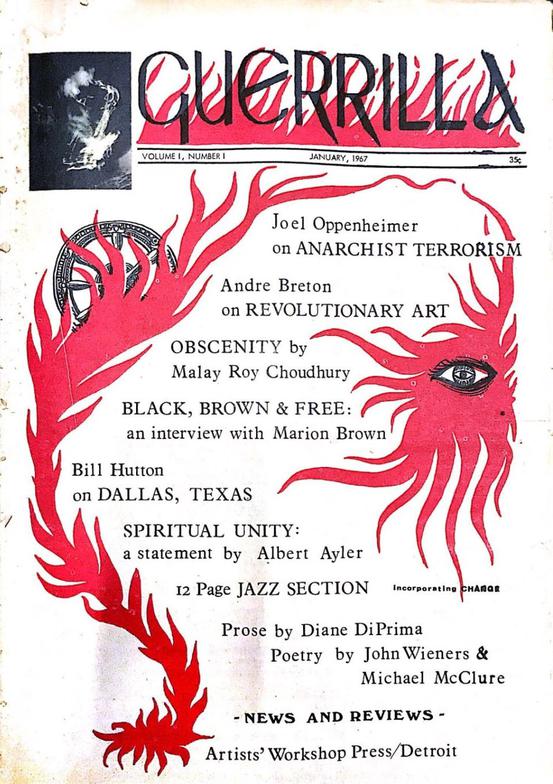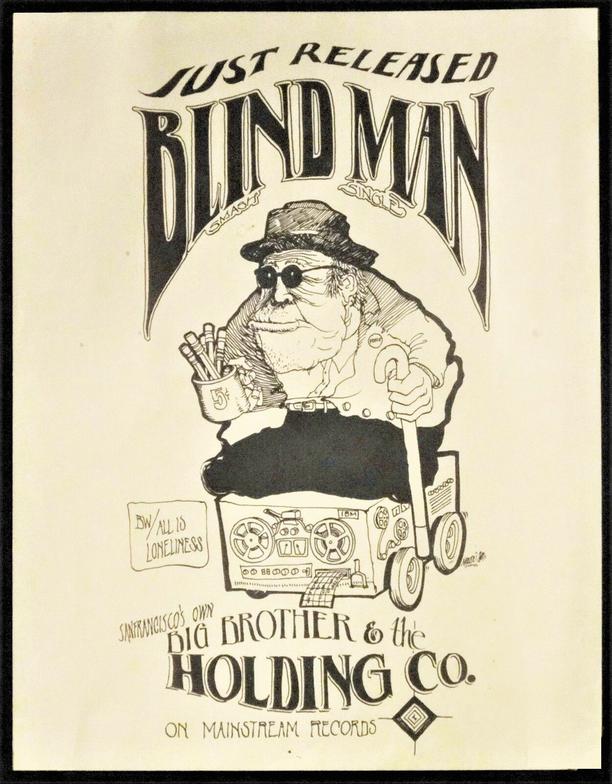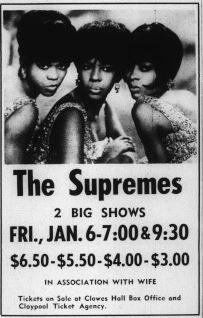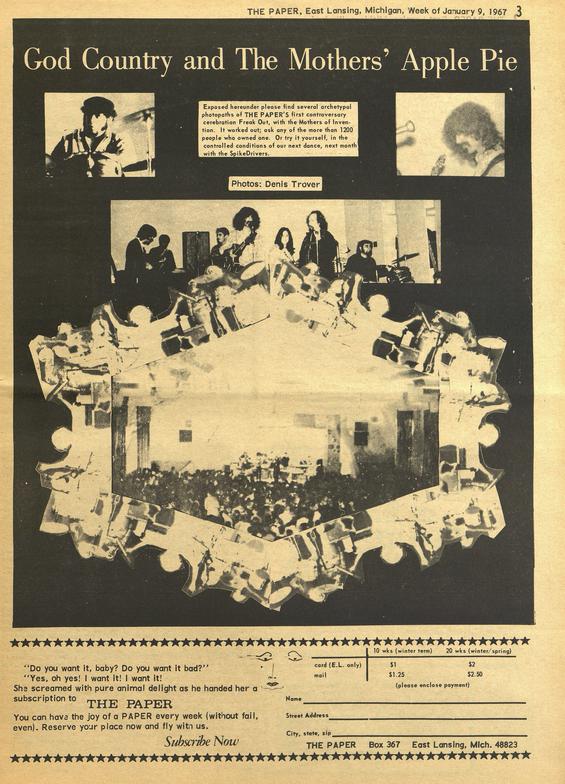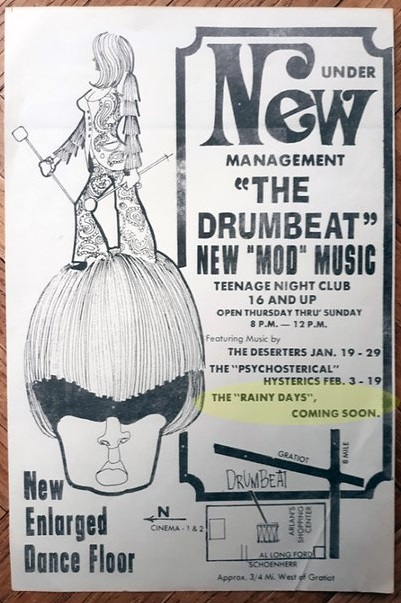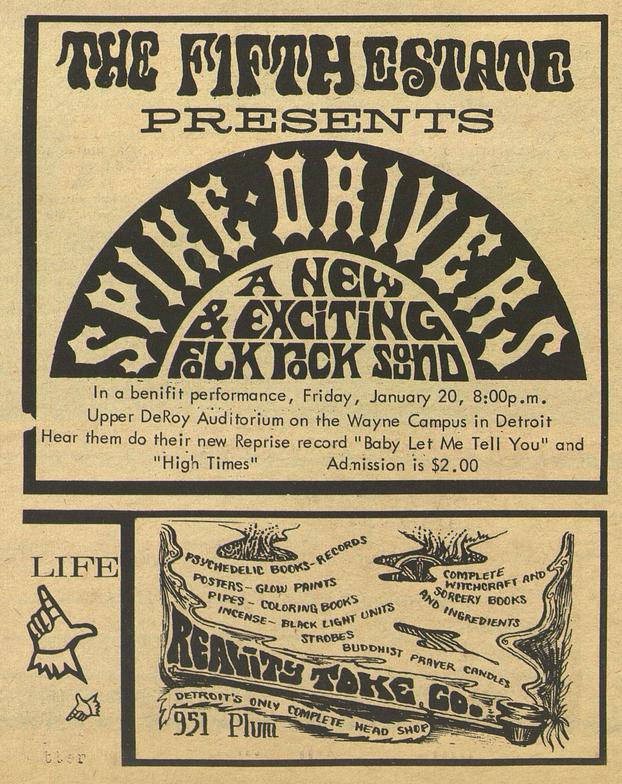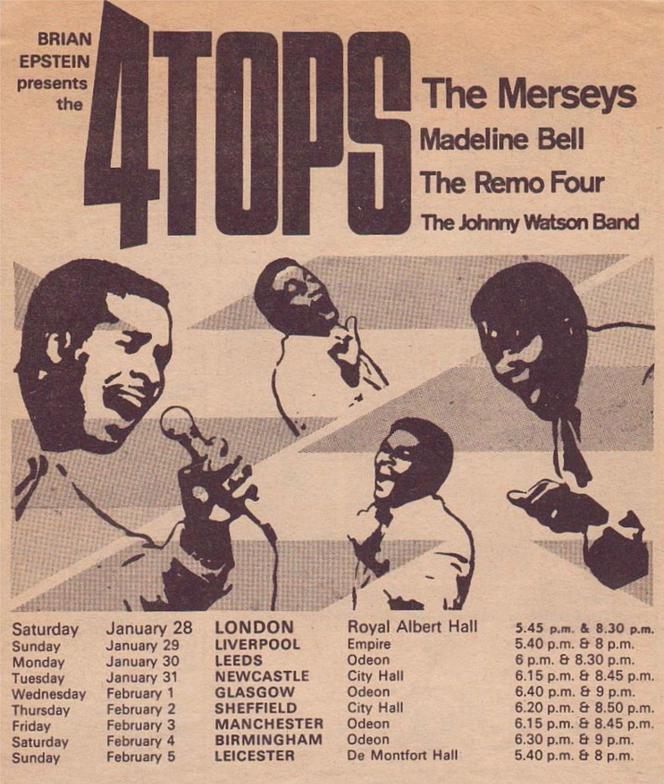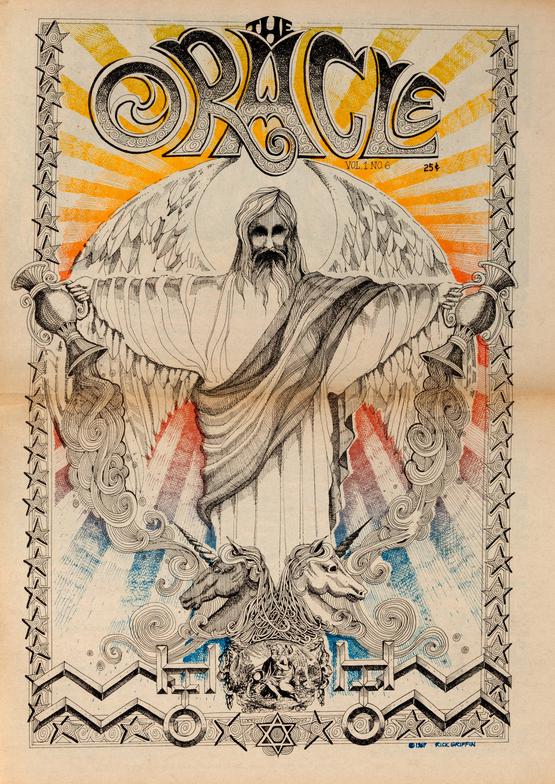Splatt Gallery
Double click here to add text.
Splatt Gallery's History of Michigan Concert Posters
Volume Three - 1967
************************************************************
John Sinclair met Allen Van Newkirk, an imposing biker/mad poet on the campus of Wayne State University in Detroit in the latter half of 1966 and quickly teamed up to produce the Guerrilla newspaper. For the Detroit Artists Workshop Press it was a vehicle to combine two current publications, “Change” and “Whe’re” into one, but for Van Newkirk, an anarchist who despised hippies as part of the revolution, had a more hardcore political agenda as the purpose for the publication.
This poster, by Leni Sinclair, was made to promote the up-coming publication.
Sinclair handed over control of Guerilla to Van Newkirk after the publication of Issue No. 1 in January, 1967, but remained a contributor. Van Newkirk moved to New York City where he joined Ben Morea and the Motherfuckers, who will come back into our story in a big way at the end of 1968. Van Newkirk did not have the finances to continue to run the newspaper so he turned to making posters, which we’ll also run into later.
The first issue of Guerilla, January 1967, with cover by Gary Grimshaw.
The Detroit Artists Workshop published Workbook #16 in January 1967, “The Sirius Poems” by Jerry Younkins, “Detroit’s first hippie”, photo by Magdalene Sinclair.
The first poster/handbill that Stanley Mouse released in 1967 was a promo for the single “Blind Man” by Big Brother & the Holding Co. He and partner Alton Kelley had produced over 30 posters in 1966, their first year of collaborating on concert posters, mostly for the Avalon Ballroom and nearly all of them for the Family Dog, with shows by Big Brother, Jefferson Airplane, Grateful Dead, Quicksilver Messenger Service, Captain Beefheart, 13th Floor Elevators and others.
Big Brother & the Holding Co. – Blind Man (1967)
https://www.youtube.com/watch?v=rsIV9tsPYkI
A Tamla Motown Records ad in the British press in January 1967.
The January 1967 Dance Schedule at Daniel’s Den in Saginaw, Michigan, with four Battle of the Bands, plus appearances by Blues Banned, Karavans, Bells of Rhymny, Gentry’s Show, Blue Widows (twice), Prodigal Sons, the Excels, Royal Coachmen, the Woolies, and the Malibus.
A non-database show (or perhaps it was cancelled) but this ad in the January 6, 1967 issue of the Michigan Daily newspaper in Ann Arbor suggest that the MC5 performed at the Union Ballroom in Ann Arbor, Michigan on this date.
A new show for the timeline and a fantastic poster by R.V. Rubyan for The MC5 at the Union Ballroom in Ann Arbor, Michigan, January 6, 1967.
An ad for the Supremes at the Clowes Hall in Indianapolis, Indiana for two shows on January 6, 1967.
The newspaper ad for the fourteenth weekend at the Grande Ballroom, January 6-7, 1967.
We have never found a poster for the Grande’s first weekend of the New Year, its 14th to date, on January 6-7, 1967. A newspaper ad bills it as a “Non-reality Dropout”, which seems to beg out for a poster somewhere. Groups that performed were the Walking Wounded, Ourselves, Seventh Seal, and MC5.
Subscription ad in the January 9, 1967 issue of The Paper newspaper in East Lansing, Michigan, using a collage of photos taken from the Mothers of Invention concert that they had sponsored in December.
An ad in a British music magazine for the single “Love Is Here And Now You’re Gone” by the Supremes, released on January 11, 1967. It became their ninth #1 single and the third in a row in the group’s second string of consecutive Number One hits.
The Supremes - Love is Here and Now You're Gone (1967)
https://www.youtube.com/watch?v=7zx89GX96ws
The following weekend, however, January 13-14, 1967, introduced the work of a new artist, Donnie Dope. Donnie Dope was an alias for Northville high school student Donald Steven Forsyth who also made posters for student-run shows at the Northville Cavern. He would also use the names Dr. Mabuse, Alice Cow, Hairy Pumpkins, Guido Ponzini, and Black Dennis for his rock posters, he’s said he found it “humorous”.
The original handbill measures approximately 8″ x 11″. No other versions are known to exist.
Ultimately, Forsyth became best known as Max Elbo, the name he took when he moved to Eureka Springs, Arkansas around 1975 and found his calling in the eclectic arts and music world of the Ozarks, becoming locally appreciated and highly regarded for his posters for numerous annual festivals throughout the years.
Here is a nearly reverent video made by the Eureka Springs Art Council on his induction into their Hall of Fame in May 2016. Max Elbo passed away less than a year later, on January 15, 2017.
https://www.youtube.com/watch?v=RQH_b49WsN8
Groups that performed at the Grande Ballroom, January 13-14, 1967, were MC5, Southbound Freeway, Cosmic Expanding, and the Grande Ballroom debut of a Taylor, Michigan band, The Unrelated Segments, who were riding high on the early success of their first record, “Story of My Life”.
The Unrelated Segments – Story of My Life (1967)
https://www.youtube.com/watch?v=XuwpA0H2RpM
The Monkees made their first Michigan appearance at the Olympia Stadium in Detroit, January 14, 1967. Contrary to expectations, for the most part the band played their own instruments, using a back-up band when each member took a turn for a solo number. Detroit Free Press Teen Writer Loraine Alterman reported that the concert was marred by the audience’s incessant screaming and the throwing of projectiles.
This was the generic first tour poster. The Monkees had performed for the first time live just a month earlier, starting their tour in Honolulu, Hawaii, when they played Detroit it was only their tenth show ever.
Poster by Stanley Mouse for the Human Be-In, January 14, 1967, in San Francisco, California.
Martine Algier, our muse from the Ann Arbor ONCE Group and the earliest days of the Detroit Artists Workshop, attended the Berkeley Poetry Conference in July, 1965 and decided to remain in San Francisco. There, she met and married artist, Michael Bowen, who was already well established in both San Francisco and New York City and had just started The San Francisco Oracle newspaper with Allen Cohen.
On October 6, 1966, the day that LSD became illegal in California, Cohen and Bowen held the “Love Pageant Rally” in Golden Gate Park which attracted a crowd of a few thousand, drawn in by the music of The Grateful Dead and Janis Joplin and a celebratory unison drop “declaration of independence”. Encouraged by the success of the event, the pair decided to organize an even bigger one.
From an off-hand remark by Bowen, it was called The Human Be-In and featured a who’s-who cast of the emerging counter-culture, Allen Ginsburg, Timothy Leary, Lawrence Ferlinghetti, Alan Watts, Dick Gregory, Jerry Rubin, and “ALL SF ROCK GROUPS”. The poster was made by Stanley Mouse, based on Bowen’s design and was also used as the cover for The Oracle to advertise the “Gathering of the Tribes”.
Exceeding all expectations, somewhere between 20,000 to 30,000 people showed up, shocking the mainstream media and launching their construct of “The Summer of Love”. In this video of the Grateful Dead performing “Viola Lee Blues” on that day, you can see Martine in a close-up face painting scene starting at 0:22.
The Grateful Dead – Viola Lee Blues (Live) (1967)
https://www.youtube.com/watch?v=3lvH6gZH3j8
And for those who might have a 26-minute interest, here is a documentary of the full day of The Human Be-In.
https://www.youtube.com/watch?v=HTGyFgyB5Q8
Poster by Double-H Press in San Francisco, California, for the Human Be-In, January 14, 1967.
By the way, since this IS about posters, here is an example of a “fake” poster, which is generally the case whenever you see one of these vintage-stylized, rip-off boxing format, often hideously colorized, and cheap, posters for sale. Often, the event is entirely fictionalized when you check the dates and locations, and they typically have atrocious errors.
In this case, both Santana and The Steve Miller Band were barely formed at the time and neither one appeared at The Human Be-In. And the photo of Timothy Leary is one that was taken at the event itself.
A full-page Liberty Records ad in the January 14, 1967 issue of Billboard magazine for the original version of “Spooky”, an instrumental written and performed by saxophonist Mike Sharpe (Shapiro). The Jacksonville, Florida band Classics IV later added lyrics to the song and made it a #3 hit on the Billboard Hot 100 singles chart in 1968.
Mike Sharpe - Spooky (1967)
https://www.youtube.com/watch?v=LRmypa9ioCk
Detroit born, Salvatore Phillip Bono moved to Inglewood, California with his family when he was seven years old. Known by his nickname “Sonny”, Bono began writing songs at age 16 and dropped out of high school to pursue a music career. He landed a job at Specialty Records and wrote a number of hit songs for other artists and for himself as a solo artist.
By November 1962, he was working for record producer Phil Spector at Gold Studios in Hollywood, when he met Cherilyn Sarkisian in a Los Angeles coffee shop. He brought her into Gold Studios as a session singer, and she sang backup on several of Spector's classic recordings, including "Be My Baby" by the Ronettes, and "You've Lost That Loving Feeling" by The Righteous Brothers.
Bono wrote songs for Cher and songs for the two of them as a duo. Their first single as Sonny & Cher, "Baby Don't Go", was a regional hit in 1964, their second single. “I Got You Babe” was #1 on the Billboard Hot 100 chart for three weeks in August 1965.
The full-page Atco Records ad shown above appeared in the January 14, 1967 issue of Billboard magazine for the single “The Beat Goes On”, their second highest charting single, peaking at #6.
Sonny & Cher – The Beat Goes On (1967)
https://www.youtube.com/watch?v=bS3O5zg290k
This newspaper ad for Simon & Garfunkel at the University of Detroit’s “Town & Gown” party on January 15, 1967 made light of the popular folk-duo’s name. It was their first Detroit appearance, however, DJ Bob Dyer in Saginaw, Michigan, had managed to book the group for a date at the Saginaw YMCA just before their song, “The Sound of Silence” became a #1 hit in January, 1966. When asked why they still honored the contract when their going rate had suddenly jumped to over four-times the agreed fee, Paul Simon responded that he wanted to see what a town with the name of Saginaw looked like.
Of course, he later famously name-checked the Michigan town in his 1968 song “America”. In 2010, the lyrics for the song began to mysteriously appear as graffiti around Saginaw on the ruins of the city’s decimated industrial and abandoned retail properties, which turned out to be the work of street artist Eric Shantz and his Paint Saginaw group.
This video gives the tour of the complete song.
Simon & Garfunkel – America (1968)
https://www.youtube.com/watch?v=-fSA-0NWPsU
This map shows the various recording studios/record labels from Detroit and gives you an idea of what we're up against as we try to document each and every one. J.J. Barnes, who recorded the George Clinton produced Beatles song in our previous post recorded for no less than fifteen of them, including Mickay’s, Kable, Scepter, Ring, Magic Touch, Golden Hit, Ric-Tic, Groovesville, Revilot, Buddah, Volt, Perception, Organic, Contempo, and Motown.
The Mickay's connection led us to this single by The Other Kind, presumably a suburban teenage rocking combo that found their way downtown to record this one-off. J. Jamison in the credits may (or may not) be Funk Brother James Jamerson, Mel Anton was a singer and part owner of the label with Fred Brown, but this sure doesn’t sound like him, and we have no idea who E. Callie is, but that is probably the key to the band.
It starts out with that Northern Soul sound, but where does that guitar freak-out come from? Makes us really want to hear the A-side, “No Time to Lend”.
The Other Kind – Can’t Wait Forever (1967)
https://www.youtube.com/watch?v=DduhORvr0Lk
Poster by an unknown artist for the Drumbeat club in Warren, Michigan, with the Deserters starting things off on January 19, 1967 through January 29th, followed by the Psychosterical Hysterics, February 3-19, and the Rainy Days “coming soon”.
Poster for The Spike Drivers at a Fifth Estate Benefit Concert at Wayne State University in Detroit, January 20, 1967, with the distinctive style of artist Connie Keelan.
Newspaper ad by Connie Keelan for The Spike Drivers at a Fifth Estate Benefit Concert at Wayne State University in Detroit, January 20, 1967, above an ad for the Relativity Toke Co. head shop on Plum Street, likely created by Gary Grimshaw.
An ad from the Fifth Estate newspaper in Detroit, Michigan for the Spike Drivers benefit concert for the newspaper at Wayne State University, January 20, 1967, with some pretty spikey lettering created by Connie Keelan. Above is an ad for the Relativity Toke Co. head shop on Plum Street.
The next poster for the Grande Ballroom was Gary Grimshaw’s eighth and covered the final two weekends of January – January 20-21,1967, and January 27-28, featuring four shows with MC5 and the Trees, Scotty’s Group with the Passing Clouds, the Plague with C-Water Blues, and MC5 with the Vernor Highway Band. “Scotty’s Group” was the one-time billing for SRC just before they took the Scot Richard Case name.
The original poster was printed on white stock and measures approximately 14″ x 21″. No other versions are known to exist.
Newspaper ad for the Grande Ballroom, January 20-21, 1967. As mentioned earlier, this was right at the transition point for the Scot Richard Case. Gary Grimshaw’s poster for this show had them billed as “Scotty’s Group”. This ad refers to them (misspelled) as “alias the Chosen Few”, the group that Scott Richardson fronted with future Stooges Ron Asheton and James Williamson, which misses the point that SRC was essentially Richardson added to the Quackenbush brothers’ group, The Fugitives.
The ad also displays the Grande Ballroom emerging practice of using nutty themes or inside jokes, often with a Tolkien Middle Earth obsession, this one asking, “Is Uncle Russ Really Gandolf”, and also notes that possession of a magic ring is allowance to waive the age restriction.
It was also neatly placed above The Detroit Free Press’ own pitch for small ads that “catch the eye”, with the perfectly accepted sexism of the times, but nevertheless a brilliant design.
A newspaper ad for the “Jazz in January” mid-winter jazz festival at Cobo Arena in Detroit, Michigan on January 22, 1967.
Program cover for a Detroit Jazz Festival, also billed as “Jazz in January” at Cobo Arena in Detroit, Michigan on January 22, 1967. Featured artists included John Coltrane, Sarah Vaughn, Dave Brubeck, Thelonious Monk, and Clark Terry.
This appears to be John Coltrane’s final Michigan performance, he would pass away on July 17, 1967 at the age of 40 years old. In addition to performing in Detroit well over 100 times since 1948, Coltrane had another Michigan connection when he married Alice McLeod of Detroit in 1965.
Poster for the Four Tops tour of England which began on January 28, 1967. This was their third trip to the UK, the first was just a meet-and-greet promotional tour in May 1965, the second was for a performance at the Saville Theatre in London that had been arranged by the Beatles’ manager Brian Epstein in November 1966. The overwhelming success of that show led to Epstein booking the group for this 1967 tour.
The Tops were the most successful male Motown act in the UK, in the United States they were second to the Temptations. The January 1967 UK tour coincided with the release of the single “Standing in the Shadows of Love” and its rise on the British charts.
The Four Tops – Standing in the Shadows of Love (1966)
https://www.youtube.com/watch?v=xhtzMwA5gJI
An ad for the Scot Richard Case (mis-spelled) at the Crazy Horse in Kalamazoo, Michigan, January 28, 1967. The show was cancelled, possibly due to severe weather, and was made up the following week, on February 4th.
Gary Grimshaw’s ninth poster was for a special, Sunday night benefit show, January 29, 1967, called Guerrilla Lovefare. The original poster was printed on tan newsprint and measures approximately 17″ x 22″. No other versions are known to exist.
John Sinclair was getting very busy, putting together coalitions of artists, musicians, and activists, launching a newspaper with Gary Grimshaw called The Warren-Forest Sun, managing The MC5 and the Plum Street bookstore, integrating the activities of the publications of The 5th Estate and The Guerrilla newspapers along with other publications, and starting the Detroit chapter of LEMAR that advocated the legalization of marijuana.
To organize all this activity, Sinclair formed the 67 Steering Committee and their first event, the Guerrilla Lovefare, was a bigger and better version of the previous workshop shows that featured poetry and jazz, and added rock and roll, a light show, “plenty of weed and acid, and the most explosive gathering of freeks in Detroit history” held at The Grande Ballroom to benefit the newly formed Detroit LEMAR.
Sinclair, already with two convictions for marijuana possession, couldn’t have painted a larger target on his back. Two undercover agents for the Detroit Police Narcotics Division, a male- female team posing as hippie candle-makers, “Louie” and “Pat” had infiltrated the scene, bugging people for weed and generally getting turned down. Frustrated after months of failing to score a deal, they seized upon a casual gift of two joints that Sinclair gave “Pat” for free at Christmas to justify a raid and on January 24th, thirty-four law enforcement officers descended onto locations around Wayne State University and arrested fifty-six people. They arrested John Sinclair during a rehearsal for the Guerrilla Lovefare show, just five days away, and he made them wait until the completion of Coltrane’s “Love Supreme” before taking him away.
The Detroit newspapers trumpeted one of the largest drug arrests in the city’s history but only a small amount of weed and some LSD (still legal in Michigan) were seized and forty-three of the fifty-six people were released without charges. But the Guerilla Lovefare show was cancelled and Sinclair, with his third offense, was potentially facing serious prison time.
Joseph Jarman – Adam’s Rib (1967)
https://www.youtube.com/watch?v=msSvmz2hwh8
In the opening paragraphs of this news clip (they just don’t write them like this anymore) Emanuel Laskey earned himself a nickname when he walked across the street from his high school and entered the offices of Thelma Records. The label was owned by Robert and Hazel Coleman who named it after their daughter, Thelma, who was Berry Gordy’s first wife. Their partner, Don Davis, had ties to Ohio, he recorded the O-Jays (whom he named) and the backing band on this track later became The Ohio Players.
Emanuel Laskey – Welfare Cheese (1963)
https://www.youtube.com/watch?v=yx4QMiGCTns
Playboy magazine ran an annual jazz poll, soliciting readers’ votes at the end of the year and publishing the results in their February issues, with a cool illustration showing the various category winners assembled into one all-star band. Beginning with the 1966 poll, the illustrations were made by the talented caricature artist, Bill Utterback.
Here is the February, 1967 “All-Star Jazz Band”, including the Supremes as the “Vocal Group”.
The February 1967 calendar for Dave Leone’s Hideout #3, which was the one in Clawson, Michigan. The Friday nights schedule included the Thyme, the Woolies, Scot Richardson Case (sic), and Bob Seger & the Last Heard.
Meditations “A Suite for John Coltrane” by John Sinclair was released as the Detroit Artists Workshop Press’ eighteenth workbook in February, 1967 with cover by Leni Sinclair and Gary Grimshaw.
The legendary underground newspaper, the San Francisco Oracle, lasted for only twelve issues, from September 1966, to February 1968, but it became the peak of psychedelic art, when Gabe Katz became the paper’s art editor starting with issue #3 and with frequent contributions by poster artists Rick Griffin, Hetty McGee, Bob Scnhepf, Stanley Mouse, and Alton Kelley.
Issue #6, published in February 1967, was a milestone when the paper switched printers to Howard Quinn Printers and the (then) revolutionary split-fountain effect was perfected. “This involved placing makeshift wooden dams in the ink fountain and using them to feed different colored inks simultaneously into the fountain, which produced a rainbow effect which was a bit difficult to read but visually arresting.”
Issue #6 was also the first (of two issues) that featured Gary Grimshaw’s art, sharing the centerfold with an essay by Alan Watts.
The front cover of Issue #6 of the San Francisco Oracle, in February 1967 with cover art by California poster artist Rick Griffin.
Program cover for the Supremes at the University of Pennsylvania in Philadelphia on February 2, 1967.
This poster by an unknown artist is a mystery, since we have not been able to confirm this show in any of the databases. Fairly certain it had to be 1967, since The Gang had been absorbed into the Amboy Dukes by January, 1968, and The MC5 are known to have played at the Grande Ballroom with Beacon Street Union on this date in 1968. Still does not prove that this show at the Somerset in Troy, Michigan on February 3, 1967 ever actually happened.
Another mystery is, what the hell is this drawing?
The artist is unknown to us even though the name(s) are clearly typed along the bottom left side, “Design by James Wolf” and “Lettering by K. Kellet”.



